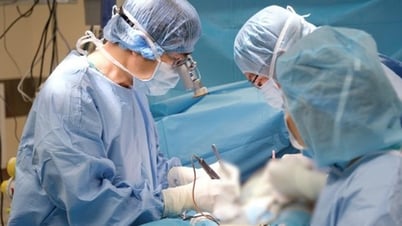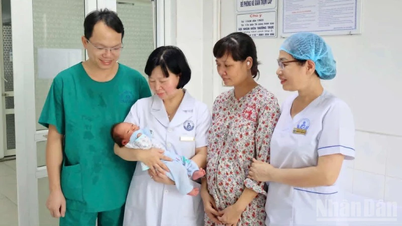The Hanoi Department of Health has just informed about the implementation of an intervention model to prevent overweight and obesity for students in a number of primary schools, reducing the burden of disease.
Medical news March 12: Worrying about the rate of overweight and obese students
The Hanoi Department of Health has just informed about the implementation of an intervention model to prevent overweight and obesity for students in a number of primary schools, reducing the burden of disease.
Worrying about the rate of overweight and obese students
In 2024, the Hanoi Center for Disease Control will coordinate with relevant units to deploy an intervention model to prevent overweight and obesity at three primary schools: Le Loi (Ha Dong), Nguyen Du (Hoan Kiem), and La Thanh (Dong Da). The model has assessed the nutritional status of 3,600 students; investigated and evaluated the practical knowledge of 1,600 parents with overweight and obese children and 250 teachers and kitchen staff of three primary schools.
 |
| Illustration photo. |
The result shows that the rate of overweight and obese students is 43.2% (Nguyen Du school 45.9%; Le Loi 43.7%; La Thanh 34.9%), and malnourished students is 3.1%.
The model has organized training for 105 health workers on methods of assessing nutritional status for primary school students; individual counseling skills for overweight and obese students.
Organize nutrition communication and advocacy to prevent overweight and obesity in students for teachers, school meal preparers, and parents with overweight and obese children at 3 schools.
Based on the investigation results, the model conducted counseling interventions for parents and students at Le Loi School, La Thanh whose children were overweight or obese, and at the same time supervised and provided professional support for individual nutrition counseling at primary schools.
Regarding activities to improve children's nutritional status, in addition to training and communication on nutrition, in 2024, the City Center for Disease Control conducted a survey and assessment of the nutritional status of children under 5 years old and surveyed the chronic energy deficiency of women of childbearing age in 60 clusters of 30 districts, towns and cities with 3,060 mother-child pairs participating.
The rate of malnutrition in children under 5 years old is 4.8%, stunting 8.8%, wasting 4.6% and overweight and obesity rate is 5.9%.
The Center has coordinated with local authorities to successfully organize the Micronutrient Day campaign in June and December, with the rate of children aged 6-35 months receiving vitamin A reaching 99.9%.
During the first phase of the Micronutrient Day campaign, 607,437 children under 5 years old were weighed and measured to assess the malnutrition rate. The results showed that the malnutrition rate of underweight was 6.6%, stunting was 9.8%, wasting was 0.3% and overweight and obesity was 1.1%.
Prevention of herpes zoster in chronically ill patients reduces medical burden
According to Associate Professor, Dr. Nguyen Trung Anh, Chairman of the Vietnam Geriatrics Association, Director of the Central Geriatrics Hospital, nearly 2/3 of people aged 60 and over have chronic diseases, of which more than half have many co-morbidities. Many studies show that co-morbid chronic diseases are factors that increase the risk of shingles, and this risk is higher when the patient has many co-morbidities.
People with chronic diseases such as heart disease, diabetes, and chronic obstructive pulmonary disease (COPD) are at higher risk of developing shingles.
Postherpetic neuralgia can have a serious impact on quality of life, including prolonged insomnia, negative psychology and some rare complications such as stroke, myelitis, cerebral arteritis. Treatment of these complications can be prolonged and expensive, especially for the elderly and those with underlying diseases, putting great pressure on the health system.
Professor, Dr. Truong Quang Binh, Chairman of the Scientific Council of the University of Medicine and Pharmacy Hospital, Ho Chi Minh City, Chairman of the Atherosclerosis Association - Vietnam Cardiology Association, said that cardiovascular patients have a 34% higher risk of getting shingles than normal people.
In particular, when having shingles, patients with stable cardiovascular disease may experience dangerous cardiovascular events such as stroke, transient ischemic attack or myocardial infarction.
Although the rate of these events is not high, they can seriously affect the quality of life and even threaten the patient's life. Therefore, proactive prevention of shingles for cardiovascular patients is extremely important.
Shingles also has a negative impact on blood sugar control. People with diabetes are at risk of getting shingles and face more severe, longer-lasting complications such as secondary infections, pain, and delayed wound healing. Meanwhile, shingles in the setting of chronic respiratory disease can worsen symptoms of chronic obstructive pulmonary disease, shortness of breath, or increase the rate of exacerbations.
In addition to the mental and physical impact, shingles also causes a medical, financial and social burden. Treatment, especially with long-term complications, can be costly, involving visits to primary care, inpatient and outpatient treatment and long-term hospitalization.
Therefore, according to Associate Professor, Dr. Le Dinh Thanh, Director of Thong Nhat Hospital, early prevention and multidisciplinary coordination play an important role in helping patients understand the risks and potential complications of shingles, especially in those with underlying medical conditions.
With timely and comprehensive advice, patients can proactively take measures to protect their health, reduce the risk of disease and complications, and improve the control of chronic diseases more effectively. This is not only a solution to improve the quality of life but also contributes to reducing the burden on the health care system.
Partial liver removal due to habit of chewing toothpick while sleeping
Information from the Central Hospital for Tropical Diseases said that the hospital had just admitted a 77-year-old man (Hanoi) with a persistent, dull abdominal pain of unknown cause.
Doctors evaluated the patient's condition and performed a CT scan. The results showed that the patient had an abscess in the left lobe of the liver, measuring more than 10 cm, with a foreign object stuck inside, which was the cause of the prolonged infection.
After careful consideration, the doctors decided to perform laparoscopic surgery to remove the left lobe of the liver to remove the foreign object and treat the abscess, preventing possible dangerous complications.
During the surgery, the doctors discovered a large abscess, more than 10 cm in diameter, located in the left lobe of the liver and attached to the small curvature of the stomach. Inside the abscess, there was a bamboo toothpick about 5 cm long that was deeply embedded in the liver parenchyma.
Fortunately, the abscess had not ruptured, otherwise the patient's life could have been in danger. After surgery, the patient was conscious and recovered quickly.
According to the medical history, the patient had a habit of chewing on bamboo toothpicks after eating, even when going to bed. This caused him to accidentally swallow the toothpicks without knowing it. Bamboo toothpicks are small, sharp and hard, and can easily pierce the stomach wall and travel to the liver, small intestine or colon. If not detected promptly, this foreign object can cause serious damage, leading to prolonged inflammation and the formation of dangerous abscesses.
Doctor Dao Thi Hong Nhung, Department of Diagnostic Imaging (Central Hospital for Tropical Diseases) said that foreign objects penetrating the liver are very rare cases. To avoid the risk of swallowing foreign objects and unfortunate consequences, people should not hold bamboo toothpicks in their mouths after eating, especially when lying down or sleeping.
If you suspect you have swallowed a foreign object, never attempt to clear your throat as this may cause the object to move deeper into the mucosa or to a dangerous location.
People should also not use folk remedies such as drinking vinegar or eating hot rice to push the foreign object down, as this can cause the foreign object to move deeper and cause serious damage. If you have symptoms of prolonged abdominal pain or fever of unknown origin, you should go to a medical facility immediately for examination and timely treatment.
Detecting lung cancer through regular health check-ups
A routine health check-up unexpectedly discovered lung cancer in a patient with no obvious clinical symptoms. Early detection of lung cancer helps improve the patient's chances of treatment and prolonging life.
Recently, Medlatec General Hospital received a special case when Mr. NQV (in Long Bien, Hanoi) came for a routine health check-up.
At the time of examination, the patient did not have any clinical symptoms such as persistent cough or difficulty breathing. However, the CT-Scanner results of the lungs detected a small tumor measuring 20.8x7.5mm in the lungs, with LUNG-RADS 4A classification, warning of the possibility of malignancy.
Doctors performed a CT-Scanner guided biopsy of the tumor and pathology results confirmed it was lung adenocarcinoma.
In addition, the EGFR gene mutation test showed that the patient had the DEL19 mutation, helping to determine the appropriate targeted treatment regimen. Thanks to the early detection of lung cancer, Mr. V. was transferred to the Oncology Hospital for timely treatment.
Lung cancer is now the leading cause of cancer death worldwide.
Despite advances in diagnosis and treatment, the disease is often detected at a late stage, leading to a high mortality rate. According to the Globocan 2022 report, Vietnam recorded 24,426 new cases and 22,597 deaths from lung cancer.
Dr. Nguyen Van Tuan, Pathology Center at MEDLATEC, said that non-small cell lung cancer (NSCLC) accounts for 80% of all lung cancer cases.
Testing for EGFR mutations plays a very important role in choosing the appropriate treatment regimen. Patients with EGFR mutations respond well to tyrosine kinase inhibitors (TKIs), which help control the disease and prolong survival.
Genetic mutation testing helps individualize treatment, avoid unnecessary methods and reduce side effects, while improving the quality of life for patients.
It is important that regular lung cancer screening can help detect the disease at an early stage, when treatment is still effective. Dr. Tran Van Thu, Deputy Head of the Department of Diagnostic Imaging, MEDLATEC General Hospital, recommends that high-risk groups should undergo regular lung cancer screening, including:
People over 50 years old. Long-term smokers. People with a family history of lung cancer. Detecting lung cancer at an early stage will increase the chance of survival and reduce the risk of metastasis. If the disease progresses to a late stage, the chance of cure is very low.
If symptoms such as unexplained persistent cough, coughing up blood, difficulty breathing, unexplained chest pain, or weight loss or fatigue appear, people should immediately go to medical facilities for timely examination and treatment. These signs can be symptoms of lung cancer and need to be detected early to have the opportunity for effective treatment.
Another case is Mr. VTL (59 years old, Hanoi) came to MEDLATEC for a checkup because of a headache accompanied by pain in the right flank. X-ray and CT-Scanner results detected a suspected malignant tumor in the left lung.
After a biopsy, the doctor determined that Mr. L. had non-small cell lung cancer. Along with gene mutation testing and immunohistochemical staining, Mr. L. was diagnosed with early stage lung cancer and will undergo appropriate treatment.
Regular lung cancer screening not only helps detect the disease early but also significantly improves the patient's chances of survival.
Methods such as CT-Scanner, EGFR gene mutation testing and immunohistochemical staining are opening up opportunities for effective and personalized treatment for each patient.
Doctors recommend that if people are in a high-risk group or have any suspicious symptoms, they should immediately get screened for lung cancer to protect their health. Do not let lung cancer become a "death scythe" when it can be prevented and treated effectively thanks to early detection.
Source: https://baodautu.vn/tin-moi-y-te-ngay-123-dang-lo-ve-ty-le-hoc-sinh-thua-can-beo-phi-d252627.html


![[Photo] Keep your warehouse safe in all situations](https://vphoto.vietnam.vn/thumb/1200x675/vietnam/resource/IMAGE/2025/10/1/3eb4eceafe68497989865e7faa4e4d0e)

![[Photo] President of the Cuban National Assembly visits President Ho Chi Minh's Mausoleum](https://vphoto.vietnam.vn/thumb/1200x675/vietnam/resource/IMAGE/2025/10/1/39f1142310fc4dae9e3de4fcc9ac2ed0)


![[Photo] Hanoi morning of October 1: Prolonged flooding, people wade to work](https://vphoto.vietnam.vn/thumb/1200x675/vietnam/resource/IMAGE/2025/10/1/189be28938e3493fa26b2938efa2059e)





















































































Comment (0)